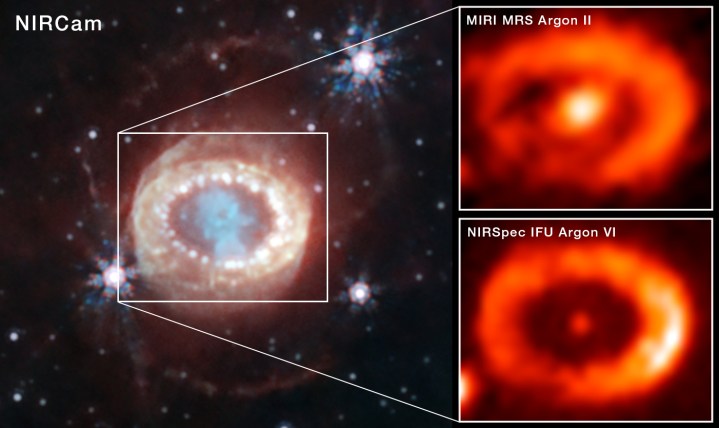When massive stars reach the end of their lives and explode in a supernova, they can leave behind huge structures in space called supernova remnants. These are often favorite targets of astronomers because of their beautiful and distinctive shapes. They include the famous SN 1987A remnant that was imaged by the James Webb Space Telescope last year. Now, astronomers using Webb have peered closer at this remnant and found something special inside.
The SN 1987A supernova was first observed in 1987 (hence its name) and was bright enough to be seen with the naked eye, making it extremely recent by astronomical standards. Stars live for millions or even billions of years, so observing one coming to the end of its life in real time is a real scientific treat. When this star died, it created a kind of supernova called a core collapse, or Type II, in which the heart of the star runs out of fuel, causing it to collapse suddenly and violently. This collapse it so severe that the material rebounds and is thrown out in an explosion traveling up to a quarter of the speed of light.

This process is theorized to leave behind a small, extremely dense core that would be either a neutron star or a black hole. This theory is widely accepted, but scientists have never observed this actually happening following a supernova — before now. When the researchers turned Webb’s instruments on SN 1987a, they saw evidence of a neutron star nestled at the heart of the remnant.
“From theoretical models of SN 1987A, the 10-second burst of neutrinos observed just before the supernova implied that a neutron star or black hole was formed in the explosion. But we have not observed any compelling signature of such a newborn object from any supernova explosion,” explained lead researcher Claes Fransson of Stockholm University in a statement. “With this observatory, we have now found direct evidence for emission triggered by the newborn compact object, most likely a neutron star.”
It has taken over 30 years of watching the remnant to be able to spot these indications of a neutron star because the observations required extremely sensitive instruments. The remnant was one of the first objects observed by Webb when it began science operations in July 2022 that included using its Mid-Infrared Instrument (MIRI). MIRI has a particular mode called Medium Resolution Spectrograph (MRS), which allows it to see the ionized argon and other ionized elements that are created by very high-energy photos.
“To create these ions that we observed in the ejecta, it was clear that there had to be a source of high-energy radiation in the center of the SN 1987A remnant,” Fransson explained. “In the paper, we discuss different possibilities, finding that only a few scenarios are likely, and all of these involve a newly born neutron star.”
By combing the evidence from MIRI with similar indications from the Near-Infrared Spectrograph (NIRSpec) instrument, the researchers have the first direct evidence of a neutron star forming from a core collapse supernova, bringing us one step closer to understanding the dramatic life cycles of stars.
The research is published in the journal Science.
Editors’ Recommendations
Services Marketplace – Listings, Bookings & Reviews